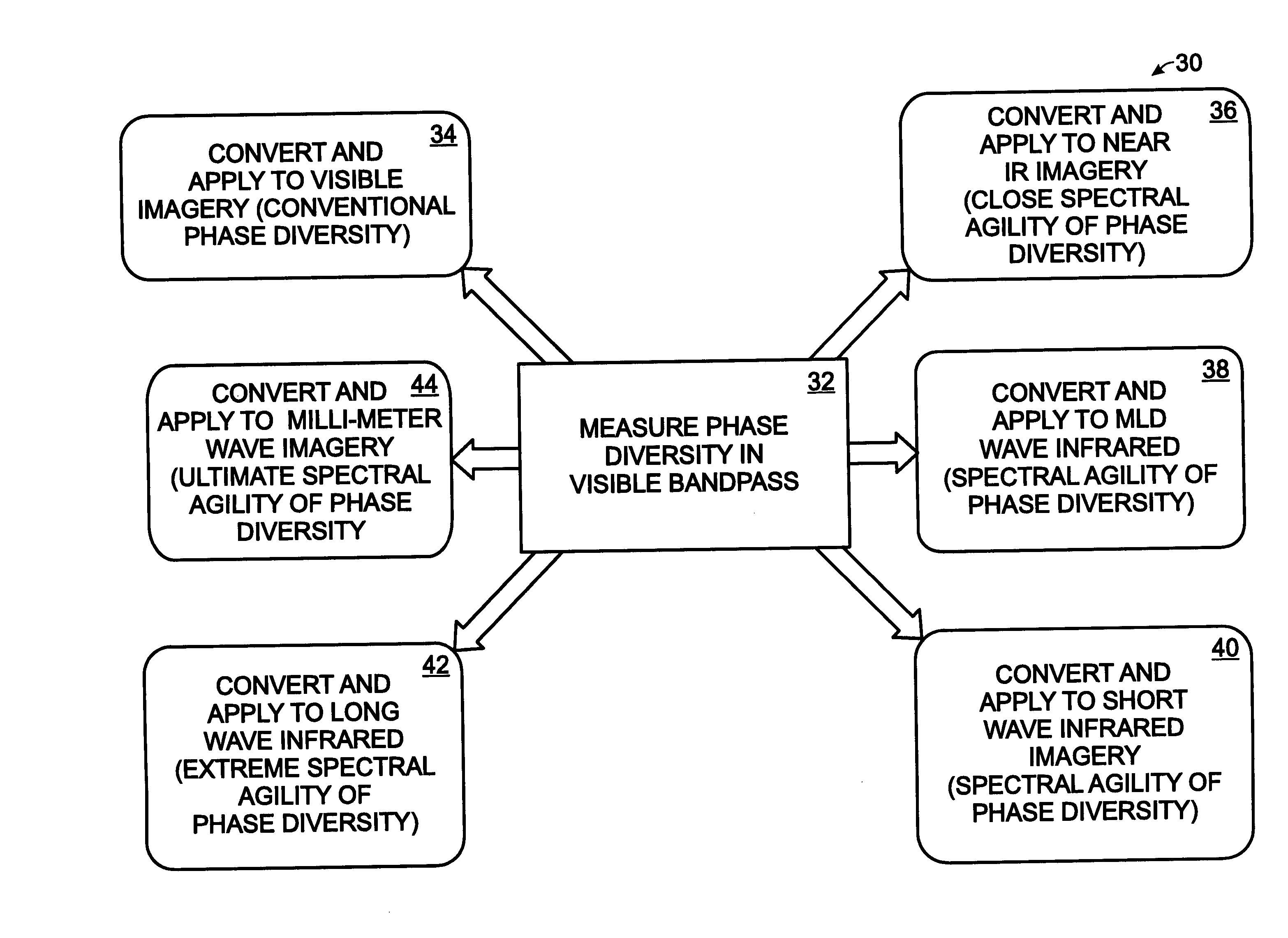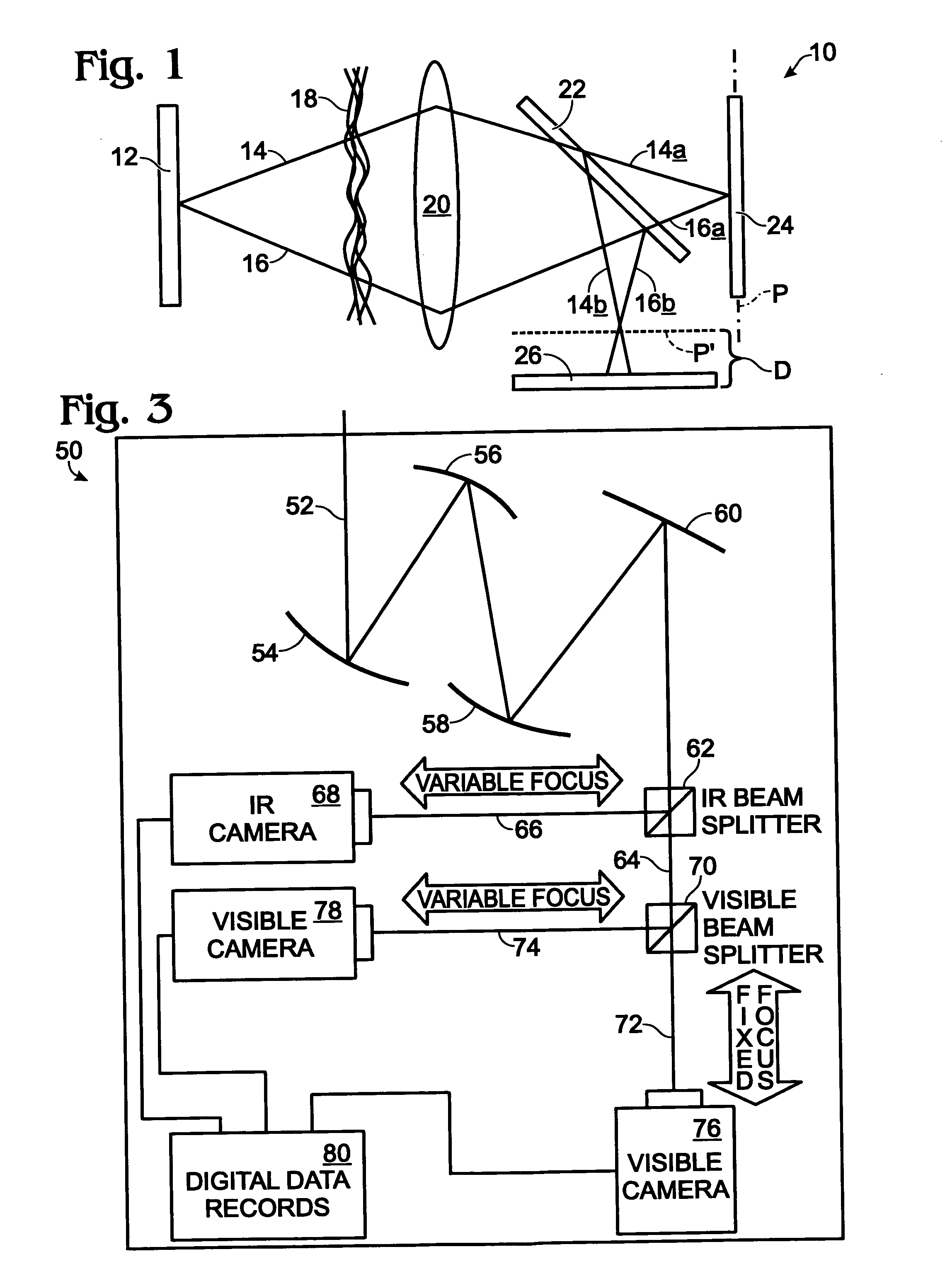Image correction across multiple spectral regimes
a technology of spectral regime and image, applied in scene recognition, instruments, computing, etc., can solve the problems of system distorted, image distorted generally, and optical limitations of instruments
- Summary
- Abstract
- Description
- Claims
- Application Information
AI Technical Summary
Benefits of technology
Problems solved by technology
Method used
Image
Examples
example 1
[0041] This section describes an example of some of the techniques described above; see FIG. 3.
[0042]FIG. 3 is a schematic diagram showing an optical system, generally indicated at 50, for using visible image data to correct an infrared image using phase diversity methods. In this example, an incoming image signal 52 arrives at the optical system, and may encounter various optical components including lenses and mirrors, such as mirrors 54, 56, 58, 60. These optical components may be used, for example, to focus, magnify, and / or redirect the incoming signal.
[0043] Signal 52 then arrives at a beamsplitter 62, which divides or splits the signal into two beams 64, 66. Beamsplitters, such as beamsplitter 62, generally comprise optical devices configured to separate electromagnetic radiation into different wavelength bands, for example, separating a visible light band from an infrared radiation band. Suitable beamsplitters (such as dichroic or multi-dichroic beamsplitters) may operate b...
example 2
[0048] This section describes additional techniques that optionally may be used with, or in lieu of, techniques described elsewhere herein for improving image acquisition and / or quality. See, e.g., U.S. Provisional Patent Application Ser. No. 60 / 696,306, filed Jul. 1, 2005, which is incorporated herein by reference in its entirety for all purposes.
[0049] Kolmogorov developed mathematical constructs for estimating atmospheric effects. In these constructs, the resolution limits imposed by the atmosphere vary with path length (to the 8 / 5th power), altitude (to the − 4 / 3 power), and sensing wavelength (to the ⅕th power). The temporal effects from the atmosphere also vary approximately with wavelength. Thus, based on these constructs, it is possible to measure the phase diversity and calculate a correction for the wavefront for longer wavelengths. Tilt of the wavefront usually is the dominant wavefront error and can be corrected merely by tilting a flat mirror, for example, as described...
example 3
[0052] This section provides an example of an image correction system, according to aspects of the present teachings, being used in an aircraft to correct infrared, millimeter-wave, and / or visible imagery in real time; see FIG. 4.
[0053]FIG. 4 shows a helicopter 100 equipped with an image correction system 102. Image correction system 102 may be substantially similar or identical to system 50, described above in Example 1 (and optionally augmented by Example 2) and depicted in FIG. 3, and may be configured to correct infrared, millimeter-wave, and / or visible imagery using visible regime phase diverse imagery. The corrected infrared or millimeter-wave imagery may be recorded and / or displayed on a heads-up display, generally indicated at 104 in FIG. 4. Thus, a pilot of helicopter 100 may use system 102 to view corrected infrared or millimeter-wave imagery in real time on display 104. In addition, system 102 may provide a second heads-up display (not shown) configured to display correc...
PUM
 Login to View More
Login to View More Abstract
Description
Claims
Application Information
 Login to View More
Login to View More - R&D
- Intellectual Property
- Life Sciences
- Materials
- Tech Scout
- Unparalleled Data Quality
- Higher Quality Content
- 60% Fewer Hallucinations
Browse by: Latest US Patents, China's latest patents, Technical Efficacy Thesaurus, Application Domain, Technology Topic, Popular Technical Reports.
© 2025 PatSnap. All rights reserved.Legal|Privacy policy|Modern Slavery Act Transparency Statement|Sitemap|About US| Contact US: help@patsnap.com



